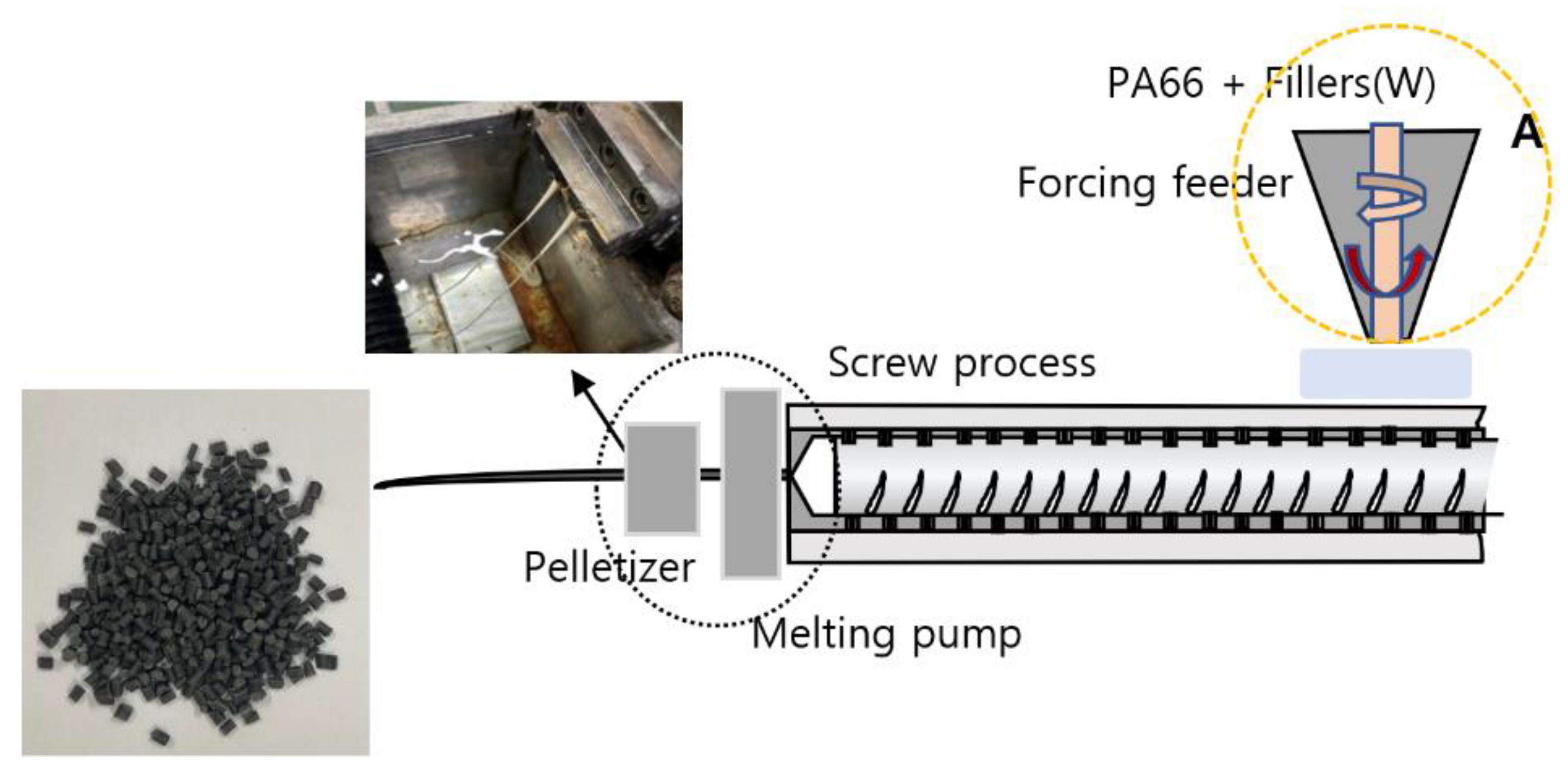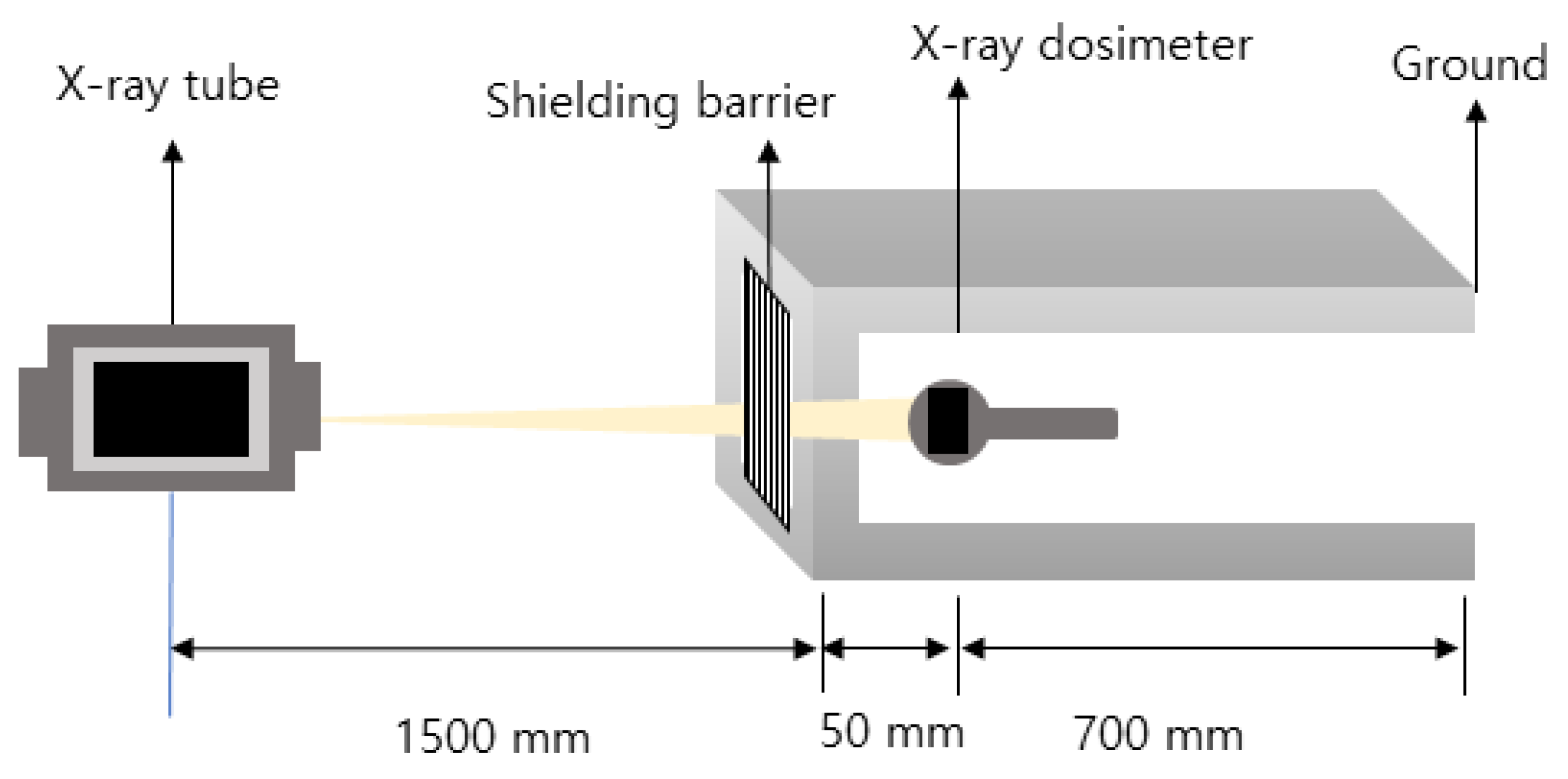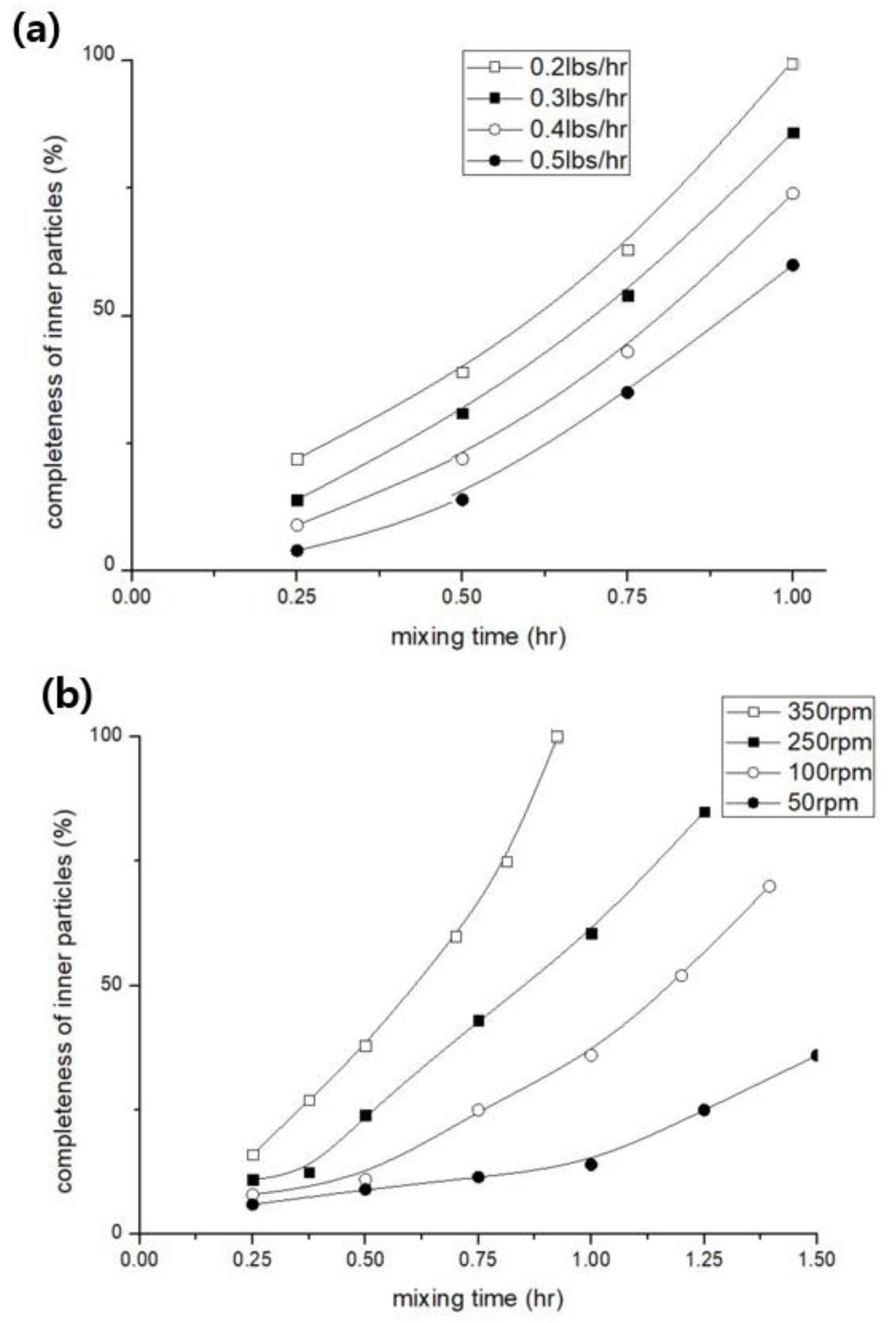Comparison of Shielding Material Dispersion Characteristics and Shielding Efficiency for Manufacturing Medical X-ray Shielding Barriers
Abstract
:1. Introduction
2. Materials and Methods
3. Results
4. Discussion
5. Conclusions
Funding
Institutional Review Board Statement
Informed Consent Statement
Data Availability Statement
Conflicts of Interest
References
- Kato, M.; Chida, K.; Muneshisa, M.; Sato, T.; Inaba, Y.; Suzuki, M.; Zuguchi, M. Non-lead protective aprons for the protection of interventional radiology physicians from radiation exposure in clinical settings: An initial study. Diagnostics 2021, 11, 1613. [Google Scholar] [CrossRef] [PubMed]
- Cheon, B.K.; Kim, C.L.; Kim, K.R.; Kang, M.H.; Lim, J.A.; Woo, N.S.; Rhee, K.Y.; Kim, H.K.; Kim, J.H. Radiation safety: A focus on lead aprons and thyroid shields in interventional pain management. Korean J. Pain 2018, 31, 244–252. [Google Scholar] [CrossRef] [PubMed]
- Chung, K.H.; Park, Y.S.; Ahn, S.B.; Son, B.K. Radiation protection effect of mobile shield barrier for the medical personnel during endoscopic retrograde cholangiopancreatography: A quasi-experimental prospective study. BMJ Open. 2019, 9, e027729. [Google Scholar] [CrossRef] [PubMed]
- Boukhris, I.; Kebaili, I.; Al-Buriahi, M.S.; Sayyed, M.I. Radiation shielding properties of tellurite-lead-tungsten glasses against gamma and beta radiations. J. Non-Cryst. Solids 2021, 551, 120430. [Google Scholar] [CrossRef]
- Al-Buriahi, M.S.; Mann, K.S. Radiation shielding investigations for selected tellurite-based glasses belonging to the TNW system. Mater. Res. Express 2019, 6, 105206. [Google Scholar] [CrossRef]
- Alavian, H.; Tavakoli-Anbaran, H. Study on gamma shielding polymer composites reinforced with different sizes and proportions of tungsten particles using MCNP code. Prog. Nucl. Energy 2019, 115, 91–98. [Google Scholar] [CrossRef]
- Uosif, M.A.M.; Mostafa, A.M.A.; Issa, S.A.M.; Tekin, H.O.; Alrowaili, Z.A.; Kilicoglu, O. Structural, mechanical and radiation shielding properties of newly developed tungsten lithium borate glasses: An experimental study. J. Non-Cryst. Solids 2020, 532, 119882. [Google Scholar] [CrossRef]
- Mahmoud, M.E.; El-Sharkawy, R.M.; Allam, E.A.; Elsaman, R.; El-Taher, A. Fabrication and characterization of phosphotungstic acid—Copper oxide nanoparticles—Plastic waste nanocomposites for enhanced radiation-shielding. J. Alloys Compd. 2019, 803, 768–777. [Google Scholar] [CrossRef]
- Avcıoğlu, S.; Buldu, M.; Kaya, F.; Üstündağ, C.B.; Kam, E.; Menceloğlu, Y.Z.; Kaptan, H.Y.; Kaya, C. Processing and properties of boron carbide (B4C) reinforced LDPE composites for radiation shielding. Ceram. Int. 2019, 46, 343–352. [Google Scholar] [CrossRef]
- Madkour, S.A.; Tirkes, S.; Tayfun, U. Development of barite-filled acrylonitrile butadiene styrene composites: Mechanical, thermal, melt-flow and morphological characterizations. Appl. Surf. Sci. Adv. 2019, 3, 100042. [Google Scholar] [CrossRef]
- Khan, M.U.; Ahmad, S.; Naqvi, A.A.; Al-Gahtani, H.J. Shielding performance of heavy-weight ultra-high-performance concrete against nuclear radiation. Prog. Nucl. Energy 2020, 130, 103550. [Google Scholar] [CrossRef]
- Li, Q.; Wei, Q.; Zheng, W.; Zheng, Y.; Okosi, N.; Wang, Z.; Su, M. Enhanced radiation shielding with conformal light-weight nanoparticle–polymer composite. ACS Appl. Mater. Interfaces 2018, 10, 35510–35515. [Google Scholar] [CrossRef] [PubMed]
- Deng, Y.; Liu, J. Liquid metal based stretchable radiation-shielding film. J. Med. Devices 2015, 9, 014502. [Google Scholar] [CrossRef]
- Rajkumar, M.L.; Vitahal, V.; Sachin, V.M.; Pankaj, P.K. Gamma radiation shielding characteristics of various spinel ferrite nanocrystals: A combined experimental and theoretical investigation. RSC Adv. 2021, 11, 7925–7937. [Google Scholar] [CrossRef]
- Akman, F.; Agar, O.; Kaçal, M.R.; Sayyed, M.I. Comparison of experimental and theoretical radiation shielding parameters of several environmentally friendly materials. Nucl. Sci. Tech. 2019, 30, 110. [Google Scholar] [CrossRef]
- Mun, H.J.; Kim, J.I.; Nam, K.D.; Gu, B.R.; Ryu, S.H. Functionalized hexagonal-shaped potassium titanate/PA66 composite for improved wear resistance. Polym. Bull. 2021, 78, 3959–3971. [Google Scholar] [CrossRef]
- Kim, Y.S.; Kim, J.K.; Jeon, E.S. Effect of the compounding conditions of polyamide 6, carbon fiber, and al2o3 on the mechanical and thermal properties of the composite polymer. Materials 2019, 12, 3047. [Google Scholar] [CrossRef]
- Korey, H.; Lynsey, N.B.; Kunal, M.; Eric, B.; Raman, P.S.; Ranji, K.V. Mechanical characterization of polyethylene-based thermoplastic composite materials for radiation shielding. Compos. Commun. 2019, 13, 37–41. [Google Scholar] [CrossRef]
- Abu AlRoos, N.J.; Azman, M.N.; Amin, N.A.B.; Zainon, R. Tungsten-based material as promising new lead-free gamma radiation shielding material in nuclear medicine. Phys. Med. 2020, 78, 48–57. [Google Scholar] [CrossRef]
- Lai, M.F.; Huang, C.H.; Lou, C.W.; Chuang, Y.C.; Wei, C.Y.; Lin, J.H. Multi-walled carbon nano-tubes/polypropylene-based coating layer on the composite metal filaments: Characteristic evaluations and radiation-shielded fabric. Fibers Polym. 2022, 23, 768–774. [Google Scholar] [CrossRef]
- Mahmoud, M.E.; El-Khatib, A.M.; Badawi, M.S.; Rashed, A.R.; El-Sharkawy, R.M.; Thabet, A.A. Recycled high-density polyethylene plastics added with lead oxide nanoparticles as sustainable radiation shielding materials. J. Clean. Prod. 2018, 176, 276–287. [Google Scholar] [CrossRef]
- Panuccio, G.; Greenberg, R.K.; Wunderle, K.; Mastracci, T.M.; Eagleton, M.G.; Davros, W. Comparison of indirect radiation dose estimates with directly measured radiation dose for patients and operators during complex endovascular procedures. J. Vasc. Surg. 2011, 53, 885–894. [Google Scholar] [CrossRef] [PubMed]
- Grazia Lourdes Monaco, M.; Carta, A.; Tamhid, T.; Porru, S. Anti-X apron wearing and musculoskeletal problems among healthcare workers: A systematic scoping review. Int. J. Environ. Res. Public Health 2020, 17, 5877. [Google Scholar] [CrossRef] [PubMed]
- Aytaç, L.; Esra, K.; Yüksel, Ö. An experimental study on the investigation of nuclear radiation shielding characteristics in iron-boron alloys. J. Alloys Compd. 2019, 819, 152946. [Google Scholar] [CrossRef]
- Jalali, M.; Mohammadi, A. Gamma ray attenuation coefficient measurement for neutron-absorbent materials. Radiat. Phys. Chem. 2008, 77, 523–527. [Google Scholar] [CrossRef]
- Olukotun, S.F.; Gbenu, S.T.; Ibitoye, F.I.; Oladejo, O.F.; Shittu, H.O.; Fasasi, M.K.; Balogun, F.A. Investigation of gamma radiation shielding capability of two clay materials. Nucl. Eng. Technol. 2018, 50, 957–962. [Google Scholar] [CrossRef]
- Jenson Joseph, E.; Akshayraj, V.R.; Panneerselvam, K. Surface modification of tungsten fillers for application in polymer matrix composites. Mater. Today Proc. 2021, 45, 7930–7933. [Google Scholar] [CrossRef]
- Török, D.; Kovács, J.G. Effects of Injection Molding Screw Tips on Polymer Mixing. Period. Polytech. Mech. Eng. 2018, 62, 241–246. [Google Scholar] [CrossRef]
- Mirji, R.; Lobo, B. Study of polycarbonate–bismuth nitrate composite for shielding against gamma radiation. J. Radioanal. Nucl. Chem. 2020, 324, 7–19. [Google Scholar] [CrossRef]
- Zschech, C.; Pech, M.; Müller, M.T.; Wiessner, S.; Wagenknecht, U.; Gohs, U. Continuous electron-induced reactive processing—A sustainable reactive processing method for polymers. Radiat. Phys. Chem. 2019, 170, 108652. [Google Scholar] [CrossRef]
- Alshahri, S.; Alsuhybani, M.; Alosime, E.; Almurayshid, M.; Alrwias, A.; Alotaibi, S. LDPE/bismuth oxide nanocomposite: Preparation, characterization and application in X-ray shielding. Polymers 2021, 13, 3081. [Google Scholar] [CrossRef] [PubMed]
- Korean Standards Association. Testing method of lead equivalent for X-ray protective devices. KSA 2017, 17, 4025. [Google Scholar]
- Feigenbaum, K.; Ellett., M.L.; Miller, R.; Hyland, L. ALARA study of teaching effectiveness on reducing radiation exposure. Gastroenterol. Nurs. 1998, 21, 234–238. [Google Scholar] [CrossRef] [PubMed]
- Pawlowski, S.; Nayak, N.; Meireles, M.; Portugal, C.A.M.; Velizarov, S.; Crespo, J.G. CFD modelling of flow patterns, tortuosity and residence time distribution in monolithic porous columns reconstructed from X-ray tomography data. Chem. Eng. J. 2018, 350, 757–766. [Google Scholar] [CrossRef]
- Jiyai, Z.; Abeykoom, C.; Karim, N. Investigation into the effects of fillers in polymer processing. Int. J. Lightweight Mater. Manuf. 2021, 4, 370–382. [Google Scholar] [CrossRef]
- Yoshiaki, M.; Koichi, C.; Takayoshi, M. Effectiveness of additional lead shielding to protect staff from scattering radiation during endoscopic retrograde cholangiopancreatography procedures. J. Radiat. Res. 2018, 59, 225–232. [Google Scholar] [CrossRef]
- Park, S.E.; Kim, H.Y.; Kim, Y.K.; Kim, E.H.; Seo, Y.S. Multilayer-structured non-leaded metal/polymer composites for enhanced X-ray shielding. MRS Adv. 2018, 3, 1789–1797. [Google Scholar] [CrossRef]
- Olsson, M.; Bushlya, V.; Lenrick, F.; Ståhl, J.-F. Evaluation of tool wear mechanisms and tool performance in machining single-phase tungsten. Int. J. Refract. Met. Hard Mater. 2021, 94, 105379. [Google Scholar] [CrossRef]
- Monzen, H.; Tamura, M.; Kijima, K.; Otsuka, M.; Matsumoto, K.; Wakabayashi, K.I.; Choi, M.G.; Yoon, D.K.; Doi, H.; Akiyama, H.; et al. Estimation of radiation shielding ability in electron therapy and brachytherapy with real time variable shape tungsten rubber. Phys. Med. 2019, 66, 29–35. [Google Scholar] [CrossRef]
- Michael, D.; Steffen, A.; Birger, H.; Ute, J.; Siegfried, B.; Carsten, B.; Mirjam, H.; Jan, H.; Michael, R. Elucidating the microstructure of tungsten composite materials produced by powder injection molding. Nucl. Mater. Energy 2020, 24, 100766. [Google Scholar] [CrossRef]
- Ambika, M.R.; Nagaiah, N.; Prashantha, K. Thermal resistance and mechanical stability of tungsten oxide filled polymer composite radiation shields. Polym. Anal. Charact. 2020, 25, 431–434. [Google Scholar] [CrossRef]
- Özkalayc, F.; Kaçal, M.R.; Agar, O.; Ploat, H.; Sharma, A.; Akman, F. Lead(II) chloride effects on nuclear shielding capabilities of polymer composites. J. Phys. Chem. Solids 2020, 145, 109543. [Google Scholar] [CrossRef]
- Vivek, P.; Hao, C.; Jiaxin, M.; Joao, M.M. Extension-dominated improved dispersive mixing in single-screw extrusion. Part 2: Comparative analysis with twin-screw extruder. J. Appl. Polym. Sci. 2020, 138, 49765. [Google Scholar] [CrossRef]






| mmPb | Effective Energy Transmission Dose | 34.8 keV (60 kVp) | 49.1 keV (80 kVp) | 55.3 keV (100 kVp) | 60.8 keV (120 kVp) | ||||
|---|---|---|---|---|---|---|---|---|---|
| Non | Lead | Non | Lead | Non | Lead | Non | Lead | ||
| 0.1 | Dose (μC/kg) | 0.107147 | 0.0176446 | 0.2259125 | 0.0614994 | 0.3866568 | 0.13932 | 0.4853831 | 0.1873518 |
| Shielding rate (%) | - | 83.53 | - | 72.78 | - | 63.97 | - | 61.40 | |
| 0.2 | Dose (μC/kg) | 0.107147 | 0.0052812 | 0.2259125 | 0.0275982 | 0.3866568 | 0.0756636 | 0.4853831 | 0.1057206 |
| Shielding rate (%) | - | 95.07 | - | 87.78 | - | 80.43 | - | 78.22 | |
| 0.3 | Dose (μC/kg) | 0.107147 | 0.0020149 | 0.2259125 | 0.014435 | 0.3866568 | 0.0466644 | 0.4853831 | 0.065944 |
| Shielding rate (%) | - | 98.12 | - | 93.61 | - | 87.93 | - | 86.41 | |
| Pre-Mixing | Effective Energy Transmission Dose | 34.8 keV (60 kVp) | 49.1 keV (80 kVp) | 55.3 keV (100 kVp) | 60.8 keV (120 kVp) | ||||
|---|---|---|---|---|---|---|---|---|---|
| Non | SB | Non | SB | Non | SB | Non | SB | ||
| Nothing | Dose (μC/kg) | 0.107147 | 0.0095305 | 0.2259125 | 0.0381504 | 0.3866568 | 0.080643 | 0.4853831 | 0.1086102 |
| Shielding rate (%) | - | 91.10 | - | 83.11 | - | 79.14 | - | 77.62 | |
| Lead equivalent | - | 0.109 | - | 0.114 | - | 0.124 | - | 0.126 | |
| Processing | Dose (μC/kg) | 0.107147 | 0.004540 | 0.2259125 | 0.021955 | 0.3866568 | 0.0639504 | 0.4853831 | 0.0931302 |
| Shielding rate (%) | - | 95.76 | - | 90.28 | - | 83.46 | - | 80.81 | |
| Lead equivalent | - | 0.201 | - | 0.206 | - | 0.208 | - | 0.207 | |
| wt% | Effective Energy Transmission Dose | 34.8 keV (60 kVp) | 49.1 keV (80 kVp) | 55.3 keV (100 kVp) | 60.8 keV (120 kVp) | ||||
|---|---|---|---|---|---|---|---|---|---|
| Non | SB | Non | SB | Non | SB | Non | SB | ||
| 50 | Dose (μC/kg) | 0.107147 | 0.0098710 | 0.2259125 | 0.040454 | 0.3866568 | 0.0914687 | 0.4853831 | 0.1248642 |
| Shielding rate (%) | - | 90.79 | - | 82.09 | - | 76.34 | - | 74.28 | |
| Lead equivalent | - | 0.109 | - | 0.113 | - | 0.120 | - | 0.121 | |
| 70 | Dose (μC/kg) | 0.107147 | 0.0064809 | 0.2259125 | 0.0227788 | 0.3866568 | 0.048207 | 0.4853831 | 0.0645309 |
| Shielding rate (%) | - | 93.95 | - | 89.92 | - | 87.53 | - | 86.70 | |
| Lead equivalent | - | 0.198 | - | 0.205 | - | 0.218 | - | 0.222 | |
| 90 | Dose (μC/kg) | 0.107147 | 0.0029102 | 0.2259125 | 0.008372 | 0.3866568 | 0.0228484 | 0.4853831 | 0.0259212 |
| Shielding rate (%) | - | 97.28 | - | 96.29 | - | 94.09 | - | 94.66 | |
| Lead equivalent | - | 0.298 | - | 0.309 | - | 0.321 | - | 0.329 | |
| Time (m) | Effective Energy Transmission Dose | 34.8 keV (60 kVp) | 49.1 keV (80 kVp) | 55.3 keV (100 kVp) | 60.8 keV (120 kVp) | ||||
|---|---|---|---|---|---|---|---|---|---|
| Non | SB | Non | SB | Non | SB | Non | SB | ||
| 0.5 | Dose (μC/kg) | 0.107147 | 0.009355 | 0.2259125 | 0.0378537 | 0.3866568 | 0.0836229 | 0.4853831 | 0.111907 |
| Shielding rate (%) | - | 91.27 | - | 83.24 | - | 78.37 | - | 76.94 | |
| Lead equivalent | - | 0.109 | - | 0.114 | - | 0.123 | - | 0.125 | |
| 1.0 | Dose (μC/kg) | 0.107147 | 0.0091022 | 0.2259125 | 0.027206 | 0.3866568 | 0.0542109 | 0.4853831 | 0.0879135 |
| Shielding rate (%) | - | 91.50 | - | 87.96 | - | 85.98 | - | 81.89 | |
| Lead equivalent | - | 0.110 | - | 0.121 | - | 0.134 | - | 0.133 | |
Publisher’s Note: MDPI stays neutral with regard to jurisdictional claims in published maps and institutional affiliations. |
© 2022 by the author. Licensee MDPI, Basel, Switzerland. This article is an open access article distributed under the terms and conditions of the Creative Commons Attribution (CC BY) license (https://creativecommons.org/licenses/by/4.0/).
Share and Cite
Kim, S.-C. Comparison of Shielding Material Dispersion Characteristics and Shielding Efficiency for Manufacturing Medical X-ray Shielding Barriers. Materials 2022, 15, 6075. https://doi.org/10.3390/ma15176075
Kim S-C. Comparison of Shielding Material Dispersion Characteristics and Shielding Efficiency for Manufacturing Medical X-ray Shielding Barriers. Materials. 2022; 15(17):6075. https://doi.org/10.3390/ma15176075
Chicago/Turabian StyleKim, Seon-Chil. 2022. "Comparison of Shielding Material Dispersion Characteristics and Shielding Efficiency for Manufacturing Medical X-ray Shielding Barriers" Materials 15, no. 17: 6075. https://doi.org/10.3390/ma15176075
APA StyleKim, S.-C. (2022). Comparison of Shielding Material Dispersion Characteristics and Shielding Efficiency for Manufacturing Medical X-ray Shielding Barriers. Materials, 15(17), 6075. https://doi.org/10.3390/ma15176075


_Low.png)



